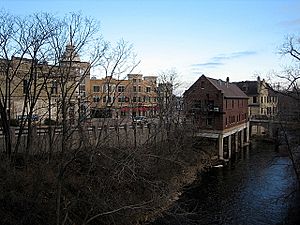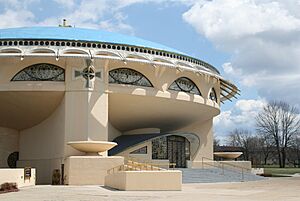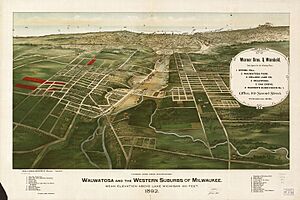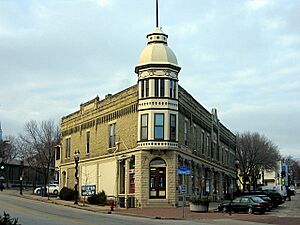Wauwatosa, Wisconsin facts for kids
Quick facts for kids
Wauwatosa, Wisconsin
|
|
|---|---|

Downtown Wauwatosa along the Menomonee River
|
|
| Nickname(s):
Tosa
|
|

Location of Wauwatosa in Milwaukee County, Wisconsin.
|
|
| Country | |
| State | |
| County | Milwaukee |
| Incorporated | May 27, 1897 |
| Area | |
| • City | 13.23 sq mi (34.27 km2) |
| • Land | 13.23 sq mi (34.26 km2) |
| • Water | 0.00 sq mi (0.01 km2) |
| Elevation | 673 ft (205 m) |
| Population
(2020)
|
|
| • City | 48,387 |
| • Density | 3,637.86/sq mi (1,404.54/km2) |
| • Metro | 1,753,355 (Milwaukee) |
| Time zone | UTC−6 (Central) |
| • Summer (DST) | UTC−5 (CDT) |
| Area code(s) | 414 |
| FIPS code | 55-84675 |
| GNIS feature ID | 1576335 |
Wauwatosa (pronounced WAW-wə-TOH-sə) is a city in Milwaukee County, Wisconsin, United States. Many people call it Tosa for short. In 2020, about 48,387 people lived there. Wauwatosa is a suburb located right next to Milwaukee and is part of the larger Milwaukee area. Its name comes from the Potawatomi Chief Wauwataesie and the Potawatomi word for firefly.
Contents
History of Wauwatosa
Early Days and First Settlers
The beautiful Menomonee Valley in the Wauwatosa area was an important path. It connected the rich farmland of southeastern Wisconsin to the Port of Milwaukee. In 1835, Charles Hart was the first European-American to settle here. Seventeen other families joined him that same year.
A year later, a United States Road was built from Milwaukee through Wauwatosa. This road eventually reached Madison. Charles Hart built a mill on the Menomonee River in 1845. This mill gave the settlement its first name: "Hart's Mill." The mill was taken down in 1914.
Becoming a Town and City
The area officially became the Town of Wau-wau-too-sa on April 30, 1840. At that time, about 342 people lived there. The town government started in 1842. The town's original borders were much larger than today. They included parts of present-day Milwaukee, West Milwaukee, and West Allis. Most of the town was farmland for many years.
In 1849, the Milwaukee-Watertown Plank Road was built through Wauwatosa. It mostly followed the old Madison road. In 1851, Wisconsin's first railroad, later called The Milwaukee Road, ended in Wauwatosa. The Village of Wauwatosa became a village in 1892. It then became the City of Wauwatosa on May 27, 1897.
City Growth and Changes
On November 25, 1952, Wauwatosa grew a lot. It added about 8.5 square miles of land west of the Menomonee River. This new area became home to large food storage and distribution centers. Factories for companies like Harley-Davidson and Briggs & Stratton were also built there.
Over the last 40 years, western Wauwatosa has become a busy commercial area. It has many shops and businesses along Milwaukee's beltline Highway 100. The Mayfair Mall is a major shopping center there.
The City Seal Change
In 1992, the Wauwatosa City Council decided to change the city's official seal. The seal had been designed in 1957 by a 9-year-old girl named Suzanne Vallier. Her design won a contest for schoolchildren.
The seal had four parts. One part showed an arrowhead for the Native Americans who first lived there. Another showed a mill for Hart's Mill, the city's original name. A third part showed a cross, representing the "city of churches." The last part showed a street sign symbol, representing the "city of homes." The cross was later replaced with the words "In God We Trust."
Events in 2020
In 2020, two serious events happened at Mayfair Mall. On February 2, a shooting occurred involving a police officer. On November 20, another shooting happened at the mall, and eight people were injured. A 15-year-old suspect was arrested the next day.
Geography and Climate
Wauwatosa's Location
Wauwatosa covers about 13.25 square miles of land. It is known for its homes and tree-lined streets, especially in the eastern part. Long ago, it was easy to get to downtown Milwaukee by streetcar.
The Menomonee Valley in Wauwatosa helped people get materials for building. They could quarry parts of the Niagara Escarpment here. This provided special cream-colored bricks and limestone for many homes and public buildings in the area.
Weather in Wauwatosa
Wauwatosa has a climate with warm summers and cold winters. Here is some information about the weather:
| Climate data for Wauwatosa, Wisconsin (Mount Mary University) 1991–2020 normals, extremes 1946–present | |||||||||||||
|---|---|---|---|---|---|---|---|---|---|---|---|---|---|
| Month | Jan | Feb | Mar | Apr | May | Jun | Jul | Aug | Sep | Oct | Nov | Dec | Year |
| Record high °F (°C) | 60 (16) |
71 (22) |
86 (30) |
90 (32) |
95 (35) |
104 (40) |
108 (42) |
108 (42) |
100 (38) |
90 (32) |
78 (26) |
68 (20) |
108 (42) |
| Mean daily maximum °F (°C) | 29.7 (−1.3) |
33.6 (0.9) |
44.3 (6.8) |
56.0 (13.3) |
67.5 (19.7) |
77.9 (25.5) |
82.8 (28.2) |
80.7 (27.1) |
73.8 (23.2) |
60.9 (16.1) |
46.8 (8.2) |
35.2 (1.8) |
57.4 (14.1) |
| Daily mean °F (°C) | 21.9 (−5.6) |
25.1 (−3.8) |
35.1 (1.7) |
46.1 (7.8) |
57.5 (14.2) |
67.9 (19.9) |
73.1 (22.8) |
71.2 (21.8) |
63.6 (17.6) |
51.2 (10.7) |
38.5 (3.6) |
27.9 (−2.3) |
48.3 (9.1) |
| Mean daily minimum °F (°C) | 14.1 (−9.9) |
16.7 (−8.5) |
25.9 (−3.4) |
36.3 (2.4) |
47.5 (8.6) |
57.9 (14.4) |
63.3 (17.4) |
61.7 (16.5) |
53.3 (11.8) |
41.6 (5.3) |
30.1 (−1.1) |
20.6 (−6.3) |
39.1 (3.9) |
| Record low °F (°C) | −27 (−33) |
−25 (−32) |
−15 (−26) |
11 (−12) |
20 (−7) |
32 (0) |
40 (4) |
41 (5) |
27 (−3) |
16 (−9) |
−8 (−22) |
−22 (−30) |
−27 (−33) |
| Average precipitation inches (mm) | 1.48 (38) |
1.49 (38) |
1.79 (45) |
3.71 (94) |
3.73 (95) |
4.84 (123) |
3.57 (91) |
3.68 (93) |
3.02 (77) |
2.73 (69) |
2.05 (52) |
1.73 (44) |
33.82 (859) |
| Average snowfall inches (cm) | 11.0 (28) |
9.9 (25) |
5.3 (13) |
1.5 (3.8) |
0.0 (0.0) |
0.0 (0.0) |
0.0 (0.0) |
0.0 (0.0) |
0.0 (0.0) |
0.0 (0.0) |
2.0 (5.1) |
9.8 (25) |
39.5 (100) |
| Average precipitation days (≥ 0.01 in) | 10.1 | 8.6 | 8.9 | 11.7 | 13.0 | 10.9 | 9.6 | 9.5 | 8.5 | 10.6 | 9.1 | 9.9 | 120.4 |
| Average snowy days (≥ 0.1 in) | 7.3 | 6.2 | 3.4 | 0.9 | 0.0 | 0.0 | 0.0 | 0.0 | 0.0 | 0.0 | 1.3 | 5.6 | 24.7 |
| Source: NOAA | |||||||||||||
People of Wauwatosa
Population Over Time
| Historical population | |||
|---|---|---|---|
| Census | Pop. | %± | |
| 1900 | 2,842 | — | |
| 1910 | 3,346 | 17.7% | |
| 1920 | 5,818 | 73.9% | |
| 1930 | 21,194 | 264.3% | |
| 1940 | 27,769 | 31.0% | |
| 1950 | 33,324 | 20.0% | |
| 1960 | 56,923 | 70.8% | |
| 1970 | 58,676 | 3.1% | |
| 1980 | 51,310 | −12.6% | |
| 1990 | 49,484 | −3.6% | |
| 2000 | 47,271 | −4.5% | |
| 2010 | 46,396 | −1.9% | |
| 2020 | 48,387 | 4.3% | |
| Note: Town of Wauwatosa annexed by City of Wauwatosa in 1952–54. |
|||
In 2010, there were 46,396 people living in Wauwatosa. There were 20,435 households, which are groups of people living together. About 27.6% of these households had children under 18. The average household had 2.23 people.
The city's population was made up of different groups:
- 89.6% White
- 4.5% African American
- 0.3% Native American
- 2.8% Asian
- 0.1% Pacific Islander
- 0.6% from other races
- 2.2% from two or more races
- About 3.1% of the population was Hispanic or Latino (of any race).
The average age in the city was 39.8 years. About 21.9% of residents were under 18 years old.
Getting Around Wauwatosa
Wauwatosa has several ways to get around. The MCTS has many bus routes that serve the city. These include Routes 21, 22, 28, 31, 33, 66, 76, and 92. There is also a special bus rapid transit (BRT) route called Connect 1.
Interstate 41 runs along the west side of the city, making it easy to travel by car. The western part of the Hank Aaron State Trail also goes through Wauwatosa. This trail is great for walking and biking.
A main train line, the Canadian Pacific Kansas City (Milwaukee Road) line, also runs through Wauwatosa. This line used to have commuter service for people traveling between Milwaukee and Watertown until 1972.
Education in Wauwatosa
The Wauwatosa School District serves the city. It includes:
- High Schools: Wauwatosa West and Wauwatosa East
- Middle Schools: Whitman and Longfellow
- Elementary Schools: Eisenhower, Jefferson, Lincoln, Madison, McKinley, Roosevelt, Underwood, Washington, and Wilson
There are also private schools in Wauwatosa. Catholic elementary schools include St. Bernard, St. Joseph, St. Jude, and Christ King. Lutheran schools include Our Redeemer and St. John's.
Places to See in Wauwatosa

Wauwatosa is home to the Milwaukee County's Regional Medical Center. This center includes the Medical College of Wisconsin, the Children's Hospital of Wisconsin, and Froedtert Hospital. Froedtert Hospital is one of only two top-level trauma centers in Wisconsin.
Other interesting places to visit include:
- The Annunciation Greek Orthodox Church, which was designed by the famous architect Frank Lloyd Wright.
- The Memorial Center, built in 1957. It has the public library, an auditorium, and the city hall.
- The Washington Highlands Historic District. This is a neighborhood designed in 1916 by a well-known city planner, Werner Hegemann. It was added to the National Register of Historic Places in 1989.
- The Kneeland-Walker House, also on the National Register of Historic Places.
- The Milwaukee County School of Agriculture and Domestic Economy Historic District.
- Wauwatosa's oldest house, the Lowell Damon House.
- The Thomas B. Hart House.
- The Wauwatosa Woman's Club Clubhouse.
In July 2019, new murals were added to buildings along North Avenue, from 64th Street to 70th Street. These artworks were created by professional artists and make the city more colorful.
Famous People from Wauwatosa
- Matt Adamczyk, businessman and politician
- Antler, poet
- Carole Barrowman, author and professor
- William Bast, screenwriter
- Henry S. Berninger, politician and businessman
- Bill Berry, musician
- Rebecca Bradley, Justice of the Wisconsin Supreme Court
- Fabian Bruskewitz, Bishop
- Milton F. Burmaster, politician and lawyer
- Matthew Busche, cyclist
- Glenn R. Davis, U.S. Representative
- Fisk Holbrook Day, physician and geologist
- Nancy Dickerson, award-winning journalist
- Sarah E. Dickson, first woman elected Presbyterian elder
- Jim Drake (director), film and television director
- Anton Falch, professional baseball player
- Charles Fingado, politician
- Charles Thompson Fisher, politician and farmer
- James L. Foley Jr., politician and farmer
- Albert Fowler, mayor of Rockford, Illinois
- Eric E. Hagedorn, politician and electrical engineer
- Devin Harris, professional basketball player
- Judson G. Hart, farmer and politician
- Stephen F. Hayes, author and political commentator
- Julius P. Heil, Wisconsin governor
- Michael W. Hoover, judge
- Mike Huwiler, Olympic athlete, MLS player
- John K. Iglehart, founding editor
- Caroline Iverson Ackerman, aviator, journalist, reporter, and educator
- Michael G. Kirby, politician
- Greg Koch, guitarist
- Christian A. Koenitzer, politician
- Mike Krol, musician
- Edwin N. Lightfoot, chemical engineer and professor
- Joseph H. Loveland, Vermont politician
- William Martz, chess International Master
- Joseph McBride, author, film historian
- Ed McCully, Christian missionary
- John Morgridge, former CEO of Cisco Systems
- Walter Nortman, politician
- Nancy Olson, American actress
- Charles B. Perry, politician
- Roger Ream, educator
- John E. Reilly Jr., politician and judge
- Peggy Rosenzweig, politician
- Brad Rowe, actor
- Pat Ryan (executive), Insurance businessman
- Jeremy Scahill. investigative journalist, author, and director
- Richard Schickel, film critic and author
- William A. Schroeder, politician and lawyer
- Nevin S. Scrimshaw, American food scientist and professor
- Steve Sisolak, Governor of Nevada
- Tony Smith, retired NBA player
- Jerry Smith, professional basketball player
- Robert R. Spitzer, agricultural researcher and President of the Milwaukee School of Engineering
- Andrew Stadler, professional soccer player
- Thomas A. Steitz, Nobel Prize-winning chemist
- Michael Torke, composer and musician
- Spencer Tracy, Hollywood actor
- Frederick D. Underwood, president of the Erie Railroad
- Scott Walker, 45th Governor of Wisconsin
- Grace Weber, singer and songwriter
- Richard S. Wheeler, American writer and newspaper editor
- David J. Wineland, Nobel Prize-winning physicist
- George Wylie, farmer and politician
See also
 In Spanish: Wauwatosa (Wisconsin) para niños
In Spanish: Wauwatosa (Wisconsin) para niños



